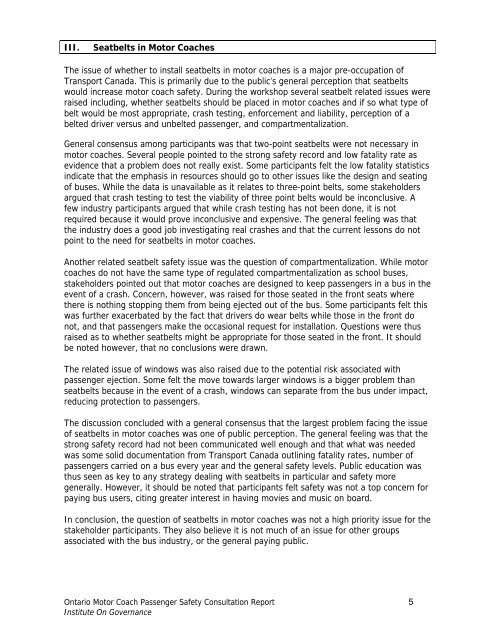Ontario Motor Coach Passenger Safety Consultation - Report -
Ontario Motor Coach Passenger Safety Consultation - Report -
Ontario Motor Coach Passenger Safety Consultation - Report -
Create successful ePaper yourself
Turn your PDF publications into a flip-book with our unique Google optimized e-Paper software.
III.<br />
Seatbelts in <strong>Motor</strong> <strong>Coach</strong>es<br />
The issue of whether to install seatbelts in motor coaches is a major pre-occupation of<br />
Transport Canada. This is primarily due to the public’s general perception that seatbelts<br />
would increase motor coach safety. During the workshop several seatbelt related issues were<br />
raised including, whether seatbelts should be placed in motor coaches and if so what type of<br />
belt would be most appropriate, crash testing, enforcement and liability, perception of a<br />
belted driver versus and unbelted passenger, and compartmentalization.<br />
General consensus among participants was that two-point seatbelts were not necessary in<br />
motor coaches. Several people pointed to the strong safety record and low fatality rate as<br />
evidence that a problem does not really exist. Some participants felt the low fatality statistics<br />
indicate that the emphasis in resources should go to other issues like the design and seating<br />
of buses. While the data is unavailable as it relates to three-point belts, some stakeholders<br />
argued that crash testing to test the viability of three point belts would be inconclusive. A<br />
few industry participants argued that while crash testing has not been done, it is not<br />
required because it would prove inconclusive and expensive. The general feeling was that<br />
the industry does a good job investigating real crashes and that the current lessons do not<br />
point to the need for seatbelts in motor coaches.<br />
Another related seatbelt safety issue was the question of compartmentalization. While motor<br />
coaches do not have the same type of regulated compartmentalization as school buses,<br />
stakeholders pointed out that motor coaches are designed to keep passengers in a bus in the<br />
event of a crash. Concern, however, was raised for those seated in the front seats where<br />
there is nothing stopping them from being ejected out of the bus. Some participants felt this<br />
was further exacerbated by the fact that drivers do wear belts while those in the front do<br />
not, and that passengers make the occasional request for installation. Questions were thus<br />
raised as to whether seatbelts might be appropriate for those seated in the front. It should<br />
be noted however, that no conclusions were drawn.<br />
The related issue of windows was also raised due to the potential risk associated with<br />
passenger ejection. Some felt the move towards larger windows is a bigger problem than<br />
seatbelts because in the event of a crash, windows can separate from the bus under impact,<br />
reducing protection to passengers.<br />
The discussion concluded with a general consensus that the largest problem facing the issue<br />
of seatbelts in motor coaches was one of public perception. The general feeling was that the<br />
strong safety record had not been communicated well enough and that what was needed<br />
was some solid documentation from Transport Canada outlining fatality rates, number of<br />
passengers carried on a bus every year and the general safety levels. Public education was<br />
thus seen as key to any strategy dealing with seatbelts in particular and safety more<br />
generally. However, it should be noted that participants felt safety was not a top concern for<br />
paying bus users, citing greater interest in having movies and music on board.<br />
In conclusion, the question of seatbelts in motor coaches was not a high priority issue for the<br />
stakeholder participants. They also believe it is not much of an issue for other groups<br />
associated with the bus industry, or the general paying public.<br />
<strong>Ontario</strong> <strong>Motor</strong> <strong>Coach</strong> <strong>Passenger</strong> <strong>Safety</strong> <strong>Consultation</strong> <strong>Report</strong> 5<br />
Institute On Governance
















